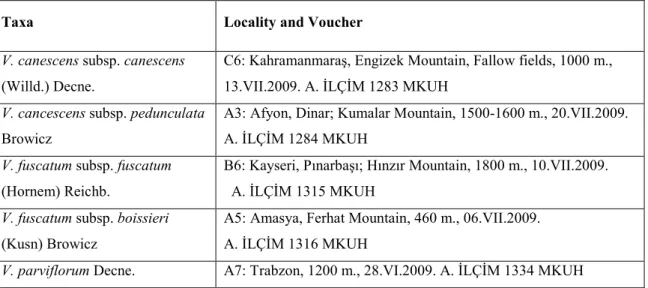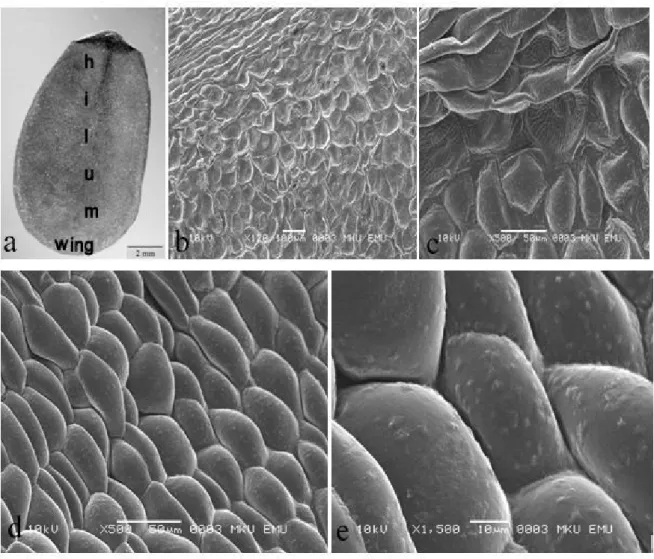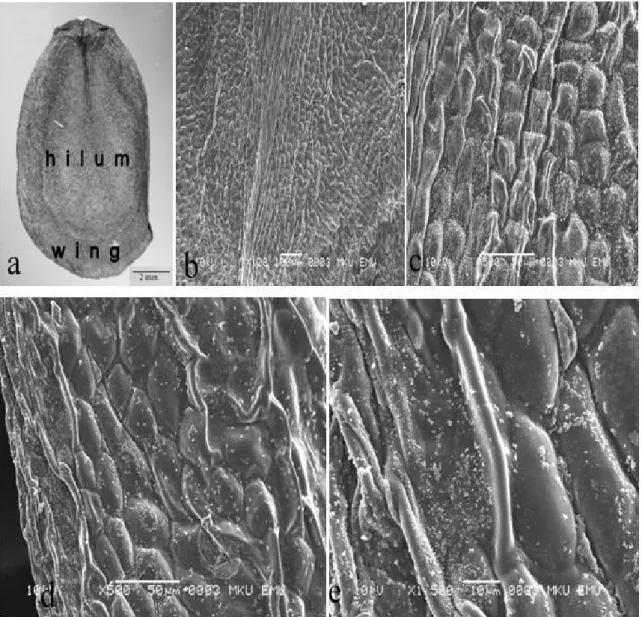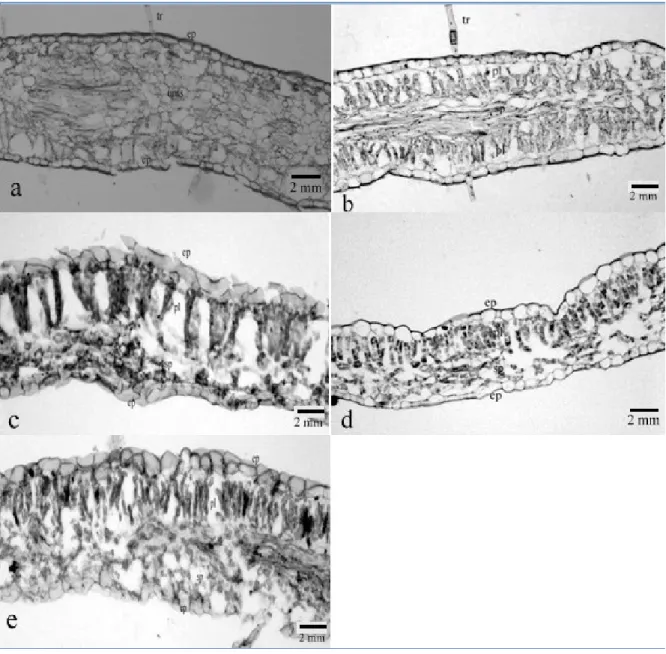AND STEM OF SOME VINCETOXICUM
(ASCLEPIADACEAE/APOCYNACEAE) SPECIES FROM TURKEY
TÜRKĐYE’DE YETĐŞEN BAZI VINCETOXICUM
(ASCLEPIADACEAE/APOCYNACEAE) TÜRLERĐNĐN YAPRAK VE DAL ANATOMĐSĐ VE EKZOMORFĐK TOHUM KARAKTERĐSTĐĞĐ
Ahmet ĐLÇĐM1, Sevda GÜZEL ÖZAY2, Gamze KÖKDĐL2 1
Mustafa Kemal University, Faculty of Arts and Science, Department of Biology, 31000 Antakya-Hatay, TURKEY
2
Mersin University, Faculty of Pharmacy, Department of Pharmacognosy, Yenişehir Campus, 33169 Mersin, TURKEY
ÖZET
Vincetoxicum NM Wolf cinsine ait 5 taksonunun ekzomorfik tohum karakteristiği ışık ve taramalı elektron mikroskobu kullanılarak araştırılmıştır. Bazı karakterlerin farklı taksonlarda değişiklik gösterdiği bulunmuştur. Bunlar tohum şekli, tohum yüzeyindeki girinti ve çıkıntılardır. Diğer karakterler ise tohum koma tüyleri, periklinal duvarların konkav/konveks olmaları ve antiklinal duvarların çeşitli derinliklerdeki kanallarıdır.
Bitkilerin gövde ve yapraklarının anatomik karakterleri belirlenmiştir. Çalışılan taksonlar Asclepiadaceae familyasının genel anatomik özelliklerine sahiptir.
Anahtar kelimeler: Vincetoxicum, Tohum Morfolojisi, Gövde ve Yaprak Anatomisi, SEM
ABSTRACT
Exomorphic seed characters of five Vincetoxicum NM. Wolf. taxa were investigated using light and scanning electron microscopy. It was found that some characters fluctuated through different expressions in
different taxa. These were shape of the seed, and sculpture of the seed coat. The latter characters were the seed coma, the concavity or convexity of the periclinal walls and the channeling of various depths of the anticlinal walls. Anatomical characters of stem and leaf of the plants were described. The studied taxa have general anatomical characteristics of the Asclepiadaceae.
Key words: Vincetoxicum, Seed Morphology, Stem and Leaf Anatomy, SEM
INTRODUCTION
The Asclepiadoideae subfamily (formerly named Asclepiadaceae) with 180 genera and 2500-3000 species is distributed mainly in the tropical and subtropical regions of the world (1-3). Most members of the subfamily have milky juice, flowers with five united petals, podlike fruits, and usually, tufted seeds (3, 4). The silky-haired seeds are drawn out of their pods by the wind and are carried off. The genus Vincetoxicum NM Wolf has been classified within the subfamily Asclepiadoideae (5). c.100 species are distributed in Asia, especially in mountain ranges, Europe and northeastern United States (6). Some European species have become invasive weeds as far north as Canada (7). The genus Vincetoxicum and its allied genera (Cynanchum L. and Tylophora R.Br.) have been investigated for a long time. Liede (1996) proposed that the genus Vincetoxicum is more similar to Tylophora than to Cynanchum based on cladistic analysis of morphological and chemical characters (6, 8).
Some Vincetoxicum species are known for their poisonous effects, as well as their medicinal properties (9). Phenanthroindolizidine alkaloids are characteristic constituents of some genera of Asclepiadaceae including the genus Vincetoxicum. Biological activities of these compounds include antibacterial, antifungal, antiinflammatory effects, also have significant cytotoxic activity against various cancer cell lines (10-12).
In Turkey, the genus Vincetoxicum is represented by 8 species and 10 taxa (13). V. parviflorum Decne., V. canescens subsp. pedunculata Browicz and V. fuscatum subsp. boissieri (Kusn) Browicz are taxa endemic to Turkey. The objective of this study is to investigate the exomorphic seed characters and anatomic characters of stems and leaves of five taxa of Vincetoxicum and to determine the systematic value of these characters. To the best of our knowledge, this is the first report on exomorphic seed characters and leaf and stem anatomy of Vincetoxicum taxa.
MATERIALS AND METHODS
Five taxa were collected from their natural habitats. Voucher specimens were deposited in the Herbarium of the Faculty of Science, Mustafa Kemal University (MKUH) and identified by
For the stem studies internodes were selected. Tissue was fixed in ethyl alcohol (70 %), dehydrated in ethyl alcohol and xylol series, and embedded in paraffin. Sections (8-20 plm) of all vegetative organs were stained with hematoxylen-eosine.
Table 1. Information on the plant materials used in this study.
Taxa Locality and Voucher
V. canescens subsp. canescens
(Willd.) Decne.
C6: Kahramanmaraş, Engizek Mountain, Fallow fields, 1000 m., 13.VII.2009. A. ĐLÇĐM 1283 MKUH
V. cancescens subsp. pedunculata
Browicz
A3: Afyon, Dinar; Kumalar Mountain, 1500-1600 m., 20.VII.2009. A. ĐLÇĐM 1284 MKUH
V. fuscatum subsp. fuscatum
(Hornem) Reichb.
B6: Kayseri, Pınarbaşı; Hınzır Mountain, 1800 m., 10.VII.2009. A. ĐLÇĐM 1315 MKUH
V. fuscatum subsp. boissieri
(Kusn) Browicz
A5: Amasya, Ferhat Mountain, 460 m., 06.VII.2009. A. ĐLÇĐM 1316 MKUH
V. parviflorum Decne. A7: Trabzon, 1200 m., 28.VI.2009. A. ĐLÇĐM 1334 MKUH
RESULTS
Seed Micromorphology
The present study shows that all seeds of five taxa have narrow wings and pappus. Detailed results of studied Vincetoxicum taxa are given below.
V. canescens subsp. canescens
The seed of this taxon have ovate shape in outline; it is characterized by a very large hilum and very narrow wings (Fig. 1. a.). The hilum of the seed consists of two different cell types. Outwards of hilum take shape with irregular, pentagonal or hexagonal cells whose periclinal walls are straight and rugulate with irregular projections. (Figs. 1. b., c.). The centre of the hilum consists
of deep concave cells. Hilum region is separated by lengthwise extended cells. The wings cells consist of sparsely granulate pentagonal or hexagonal cells (Figs. 1. d., e.).
Figure 1. V. canescens subsp. canescens, a. General view of seed; b, c. hilum cells; d, e. wing cells
V. canescens subsp. pedunculata
This subspecies has ovate seeds with narrow wings like in subsp. canescens (Fig. 2. a.). But clearly differs from it by homogeneous hilum and wing cells (Figs. 2. b., c.). In this taxa, seed hilum and wing consist of deep concave cells (Figs. 2. d., e.).
Figure 2. V. canescens subsp. pedunculata a. General view of seed; b, c. hilum cells; d, e. wing cells
V. fuscatum subsp. fuscatum
The seed of the species consists of two regions; hilum and wing (Fig. 3. a.). Hilum region is distinguished by lengthwise extended cells. Hilum and wing cells are differentiated from each other with the cell shapes and ornamentation. Tetragonal hilum cell walls very thin; almost inconspicously thickened. These cells have very small numerous granules at cell surfaces (Figs. 3. b., c.) Wing cells long, sometimes narrowed at the middle and have grape like secondary structures on outer walls (Figs. 3. d., e.).
Figure. 3. V. fuscatum subsp. fuscatum a. General view of seed; b, c. hilum cells; d, e. wing cells
V. fuscatum subsp. boissieri
This seed is similiar to other taxa in macromorphology (Fig. 4. a.). Hilum consists of tetragonal and irregular cells (Figs. 3. b., c.) (Figs. 4. b., c.). Like in V. fuscatum subsp. fuscatum, hilum cells have very small numerous granulous secondary structures. Some of the these cell walls have longitudinal lines and irregular appendages. Wing cells have tetragonal or pentagonal shapes. At this region, longitudinally raised cells observed (Figs. 4. d., e.).
Figure 4. V. fuscatum subsp. boissieri a. General view of seed; b, c. hilum cells; d, e. wing cells
V. parviflorum
The seeds consists of two regions like in other species, hilum and wing region (Fig. 5. a.). Cells of this two regions differ from each other in respect to shape and ornamentation. The hilum consists of irregular, circular or quadrature cells with thickened periclinal walls. These cells have numerous grains on upper cell walls (Figs. 5. b., c.) At the middle of the hilum, lengthwise extended cells have thickened walls. Wing cells have circular or rectangular shapes. These cells have granules and flat appendages on the walls (Figs. 5. d., e.).
Figure. 5. V. parviflorum a. General view of seed; b, c. hilum cells; d, e. wing cells
Stem Anatomy
The anatomy of the herbaceous stems of five taxa are similar in general shape and tissue organisation. A thick mature stem cross section shows semi-circular outline with one or two layers of epidermis, when consisting of two layers, upper epidermal cells are smaller than, the lower ones. The stem cortex is a very large region between the epidermis and the vascular cylinder. The cortex of V. canescens subsp. canescens and V. parviflorum contain two layers of chlorenchyma cells under epidermal cells (Fig. 6. a.), the cortex contain secretion channels as a difference from other species in V. canescens subsp. pedunculata and V. canescens subsp. canescens stems (Figs. 6. a., b.). The patches of phloem fibres occur in the cortex of V. canescens subsp. canescens, V. fuscatum
of 7-12 row of cells. The cells usually have pentagonal shapes. Less external and internal phloem clusters occur in the stems of all taxa.
Leaf Anatomy
In all species the epidermis consists of cubical or somewhat conical shaped cells, covered by thick cuticle and sparse simple trichomes or glabrous. Stomata are of hypostomatic and anomocytic type. Mesophyll cells are differentiated into palisade and spongy parenchyma, or consist of uniform cells. Mesophyll is bifacial or monofacial. If mesophyll is bifacial, palisade parenchyma is present below the upper epidermis, consists of vertically elongated continuous single layered cells. Spongy parenchyma lies below the palisade parenchyma and is loosely arranged (Fig. 7.). While the leaf of V. canescens subsp. canescens (Fig. 7. a.) has monofacial mesophyll, the leaf of V. fuscatum subsp. fuscatum, V. parviflorum and V. fuscatum subsp. boissieri have bifacial mesophyll. The leaf mesophyll of V. canescens subsp. pedunculata differs from other species by isobilateral mesophyll (Fig.7. b.).
a
b
a
c
Figure 6. Stem anatomy of a. V. canescens subsp. canescens, b. V. canescens subsp. pedunculata, c. V. fuscatum subsp. fuscatum, d. V. fuscatum subsp. boissieri, e. V. parviflorum. (ep: epidermis, co: cortex, sc: secretion channel, sp: sclerenchyma patch, sc: sclerenchyma, eph: external phloem, xy: xylem, iph: internal phloem, pt: pith)
Figure 7. Leaf anatomy of a. V. canescens subsp. canescens, b. V. canescens subsp. pedunculata, c. V. fuscatum subsp. fuscatum, d. V. fuscatum subsp. boissieri, e. V. parviflorum. (ep: epidermis, tr: trichome, pl: palisade parenchyma, sp: sponge parenchyma)
DISCUSSION
The light microscopy shows that the seeds have ovate shapes. Seed dimensions vary as well; the largest dimensions (8.3-8.7 mm L. x 4.3-5.3 mm W.) are seen in V. canescens subsp. pedunculata, and the smallest dimensions (6.0-7.7 mm L. x 4.0-4.5 mm W.) in V. fuscatum subsp. boissieri. All seeds of five taxa have narrow wings and pappus. The present investigation showed
that all seeds have similar properties at outline. Seed shapes and dimensions are not usable systematically (Table 2).
Table 2. Comparison of the seed characteristics of five Vincetoxicum taxa.
Taxa Seed length (mm) Seed width (mm) Wing width at base (mm) Wing width at apex (mm) Wing width at edge (mm) V. canescens subsp. canescens 7.1-8.6 4.8-5.3 0.0-0.1 0.0-0.1 0.0-0.1 V. canescens subsp. pedunculata 8.3-8.7 4.3-5.3 0.0- 0.1 0.1-0.2 0.0-0.1 V. fuscatum subsp. fuscatum 6.7-8.5 4.0-4.8 1.0-1.9 0.5-1.1 0.5-1.0 V. fuscatum subsp. boissieri 6.0-7.7 4.0-4.5 1.0-1.4 0 0.7-1.0 V. parviflorum 6.7-8.4 3.6-3.8 0.2-0.5 0.3-1.5 0.2-0.3
However, micromorphological properties of studied Vincetoxicum taxa seeds exhibited some similarities and differences compared to each other. The seed of V. canescens subsp. canescens have two different cells on hilum. Outwards of hilum have irregular, pentagonal or hexagonal shape cells with straight and rugulate periclinal walls with irregular projections (Fig. 1. b.). The centre of the hilum consists of deep concave cells (Fig. 1. c.). However V. canescens subsp. pedunculata has homogeneous hilum cells (Figs. 2. c., d.). The seed hilum and wing consist of deep concave cells (Figs. 2. d., e.).
Hilum of V. fuscatum subsp. fuscatum is characterized by tetragonal, almost inconspicously thickened cells with numerous small granular secondary structures (Figs. 3. b., c.) The hilum of the V. fuscatum subsp. boissieri has tetragonal and irregular cells and small granules (Figs. 4. b., c.). Wing cells of V. fuscatum subsp. fuscatum are sometimes narrowed at the middle and have grape like secondary structures on outer walls (Figs. 3. d., e.), but the wing cells of V. fuscatum subsp. boissieri only consist of polygonal cells (Figs. 4. d., e.).
Micromorphological properties of V. parviflorum differ from other taxa. Hilum cells of this taxa are tetragonal and concave irregular, and have numerous grains on walls (Figs. 5. b., c.). Some of the these cell walls have longitudinal lines and irregularly raised appendages. Wing cells have circular or rectangular shapes. The cells have granules and flat appendages on walls (Figs. 5. d., e.).
To the best of our knowledge there is no information on the anatomy of Vincetoxicum genus in the literature. But several studies can be found on Araujia, Cynanchum, Asclepias and
The results indicate that the morphological and anatomical characteristics would be helpful for the identification of Vincetoxicum taxa.
REFERENCES
1. Yamashiro T, Yamashiro A, Yokoyama J, Maki M, Morphological aspects and phylogenetic analyses of pollination systems in the Tylophora–Vincetoxicum complex (Apocynaceae-Asclepiadoideae) in Japan, Biological Journal of the Linnean Society, 93, 325-341, 2008.
2. Mahmood T, Tarıq A, Nazar N, Abbasi BH, Naqvi SMS, Comparative assessment of genetic variability in Cryptolepis buchananii, Tylophora hirsuta and Wattakaka volubilis, Pakistan Journal Botany, 43(5), 2295-2300, 2011.
3. Heywood VH, Brummitt RK, Culham A, Seberg O, Flowering plant families of the world, Firefly Books, 38-40, 2007.
4. EncyclopediaBritannica,2012.www.britannica.com/EBchecked/topic/37943/Asclepiadaceae
5. Stærk D, Nezhad KB, Asili J, Emami SA, Ahi A, Sairafianpour M, Jaroszewski JW, Phenanthroindolizidine alkaloids from Vincetoxicum pumilum, Biochemical Systematics and Ecology, 33, 957-960, 2005.
6. Liede S, Cynanchum-Rhodostegiella-Vincetoxicum-Tylophora (Asclepiadaceae): new considerations on an old problem, Taxon, 45, 193-211, 1996.
7. Averill KM, DiTommaso A, Mohler CL, Milbrath LR, Establishment of the invasive perennial
Vincetoxicum rossicum across a disturbance gradient in New York State, USA, Plant Ecology, 211,
65-77, 2010.
8. Liede S, Kunze H, Cynanchum and the Cynanchinae (Apocynaceae-Asclepiadoideae): a molecular, anatomical and latex triterpenoid study, Organisms Diversity&Evolution, 2, 239-269, 2002.
9. Staerk D, Christensen J, Lemmich E, Duus J, Olsen CE, Jarszewski JW, Cytotoxic activity of Some phenanthroindolizidine N-oxide alkaloids from Cynanchum vincetoxicum, Journal of Natural Products, 63, 1584-1586, 2000.
10. Ciufolini MA, Roschangar F, A unified strategy fort he synthesis of phenanthroizidine alkaloids: preparation of sterically congested pyridines, Journal of the American Chemical Society, 118, 12082-12089 1996.
11. Su CR, Damu AG, Chiang PC, Bastow KF, Morris-Natschke SL, Lee KH, Wu TS, Total synthesis of phenanthroindolidine alkaloids (±)-antofine, (±)-deoxypergularinine, and their dehydro congeners and evaluation of their cytotoxic activity, Bioorganic&Medicinal Chemistry, 16, 6233-6241, 2008. 12. Staerk D, Lykkeberg AL, Christensen J, Budnik BA, Abe F, Jaroszewski JW, In vitro cytotoxic
activity of phenantroindolizidine alkaloids from Cynanchum vincetoxicum and Tylophora tanakae against drug-sensitive and multidrug-resistant cancer cells, Journal of Natural Products, 65, 1299-1302, 2002.
13. Browicz K, Vincetoxicum N.M. Wolf. In: Davis P.H., ed., Flora of Turkey and the East Aegean Islands. Edinburgh: University Press, 6, 163-173, 1978.
14. Nawaihi AS, Hassan SA, Elwan ZA, Exomorphic seed characters of some species of the Apocynaceae s.l. in Egypt, Feddes Repertorium, 117 (7-8), 437-452, 2006.
15. Bucciarelli A, Cambi VN, Villamil CB, Morphoanatomical characters of Araujia hortorum E. Fourn (Asclepiadaceae), a native species of medicinal interest, Phyton-Internatıonal Journal of Experimental Botany, 77, 283-295, 2008.
16. Lucansky TW, Clough T, Comparative anatomy and morphology of Asclepias perennis and
Asclepies tuberosa subsp. rolfsii, Botanical Gazette, 147(3), 290-301, 1986.
17. Poornima N, Umarajan KM, Babu K, Studies on anatomical and phytochemical analysis of
Oxystelma esculentum (L.f.) R.br. Ex Schltes, Botany Research International, 2 (4), 239-243, 2009.
Received: 28.12.2012 Accepted: 07.01.2013






